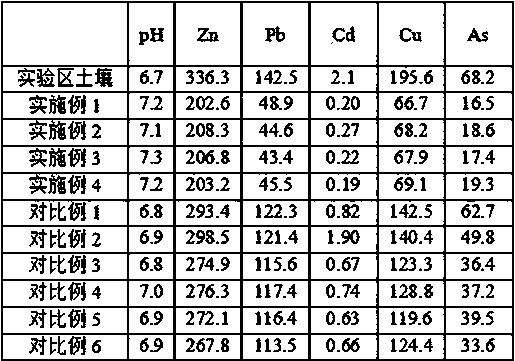A combined biochar and phytoremediation method for heavy metal-contaminated soil
A technology for joint restoration and contaminated soil, applied in the field of contaminated soil treatment, can solve the problems of single heavy metal restoration element, low heavy metal absorption efficiency, long restoration time, etc., and achieves the effects of low planting difficulty, degradation of heavy metal pollution, and low cost.
- Summary
- Abstract
- Description
- Claims
- Application Information
AI Technical Summary
Problems solved by technology
Method used
Image
Examples
Embodiment 1
[0040] 1) Choose H that passes 20% 2 o 2 Disinfection treatment was followed by washing and soaking in distilled water for 12 hours. The annual SGK321 Bt-transgenic cotton seeds with plump and sinking grains grew into healthy seedlings of 30 cm and were buried in the soil surface at a depth of 15 cm along the vertical direction at an inclination of 30 degrees. The plant spacing was 20 cm and the row spacing was 25 cm. Irregular watering and weeding to ensure the normal growth of cotton. In late April, the annual SGK321 transgenic Bt cotton was planted in the test field. The cycle from planting to cotton picking was regarded as a cycle, and two cycles were planted continuously. After the cotton fruits were picked in the cotton mature season in each cycle, the cotton plants were treated. to remove in its entirety;
[0041] 2) After the cotton plants are removed as a whole in step 1), apply the biochar-based fertilizer into the heavy metal-polluted soil where cotton has been pl...
Embodiment 2
[0048] 1) Choose H that passes 20% 2 o 2 Disinfection treatment and then washing and soaking in distilled water for 12 hours. The annual TM-1 upland cotton seeds with plump and sinking seeds grow into healthy seedlings of 30 cm and are buried in the soil surface at a depth of 15 cm along the vertical direction at an inclination of 30 degrees. The plant spacing is 20 cm and the row spacing is 25 cm. Irregular watering and weeding to ensure the normal growth of cotton. In late April, two cycles of annual TM-1 upland cotton were continuously planted in the test field. The cycle from cotton planting to cotton picking was taken as a cycle. After picking the cotton fruits in the mature season of TM-1 upland cotton, the cotton plants were tested remove in its entirety;
[0049] 2) After the cotton plants are removed as a whole in step 1), apply the biochar-based fertilizer into the heavy metal-polluted soil where cotton has been planted in step 1), mix well, and age for 60 days;
...
Embodiment 3
[0056] 1) Choose H that passes 20% 2 o 2 Disinfection treatment and then washing and soaking in distilled water for 12 hours. The TM-1 upland cotton seeds with plump and sinking seeds grow into healthy seedlings of 30 cm and are planted at a depth of 10 cm in the soil surface at an inclination of 30 degrees in the vertical direction, with a plant spacing of 25 cm and a row spacing of 25 cm. Irregular watering and weeding to ensure the normal growth of cotton. In late April, two cycles of annual TM-1 upland cotton were continuously planted in the test field, taking cotton planting and cotton picking as a cycle, and after the cotton fruits were picked in the cotton mature season, the TM-1 upland cotton plants were tested. remove in its entirety;
[0057] 2) After the cotton plants are removed as a whole in step 1), apply the biochar-based fertilizer into the heavy metal-polluted soil where cotton has been planted in step 1), mix well, and age for 60 days;
[0058] 3) After th...
PUM
 Login to View More
Login to View More Abstract
Description
Claims
Application Information
 Login to View More
Login to View More - R&D
- Intellectual Property
- Life Sciences
- Materials
- Tech Scout
- Unparalleled Data Quality
- Higher Quality Content
- 60% Fewer Hallucinations
Browse by: Latest US Patents, China's latest patents, Technical Efficacy Thesaurus, Application Domain, Technology Topic, Popular Technical Reports.
© 2025 PatSnap. All rights reserved.Legal|Privacy policy|Modern Slavery Act Transparency Statement|Sitemap|About US| Contact US: help@patsnap.com

